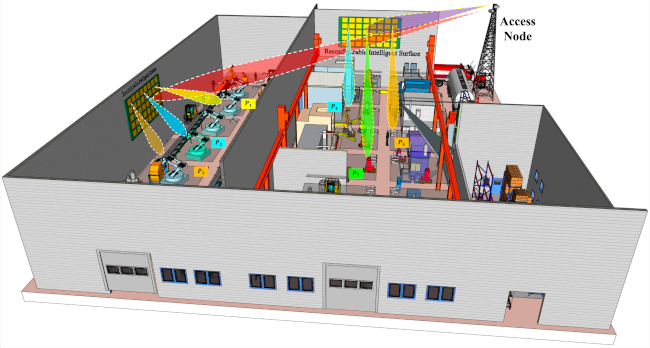Researchers are excited about a recent breakthrough in wireless communications, which could significantly enhance indoor location tracking for both people and objects.
Engineers from the University of Glasgow and colleagues from the UK and Australia are behind the research breakthrough. Their work could have a wide range of future applications, from helping emergency services quickly find people trapped in smoke-filled buildings to offering device-assisted navigation through public spaces for blind and partially-sighted people.
It could also help finally eliminate the need to move around indoors to find the best spot to make a mobile phone call.
In a new paper published in the journal Communications Engineering, the research team describe how they collaborated to improve the performance of an emerging wireless communication technology called Reconfigurable Intelligent Surfaces, or RIS.
RIS takes the form of flat surfaces which use programmable elements capable of manipulating electromagnetic waves, like the high-frequency signals of wireless communications, for a range of applications.
Sheets of RIS placed on walls and ceilings indoors can intercept wireless signals from outside and intelligently reflect, redirect and focus them as required to improve performance.
As RIS development progresses and the technology is integrated into existing 5G and future 6G communications networks, it could help solve a longstanding problem with the performance of more established positioning technologies like GPS.

Professor Qammer Abbasi, of the University of Glasgow’s James Watt School of Engineering, led the research and is the paper’s corresponding author. He said:
“While GPS works very well outdoors, helping us to use mapping apps to find our way efficiently on foot or in a vehicle, it works considerably less well in indoor environments. Positioning communication signals can be weakened by thick walls or interfered with by other electronic signals, reducing the accuracy of GPS.
“RIS has the potential to greatly improve active location-finding indoors. It can do that by being aware of the communications signals being sent and received from devices like mobile phones at any given time, which allows them to precisely locate the device and its user.
“That opens up a wide range of possible applications, including tapping into RIS’ ability to focus signals to improve call quality by directing signals straight to mobile phones’ antennae, no matter where their user moves indoors.
“Our research is an important step forward in fine-tuning RIS technology’s ability to perform indoor localisation tasks in future comms networks.”
To explore and improve the technology’s location-finding potential, they set up a 1.3m-square RIS containing 4,096 elements in a space at the University of Glasgow. They paired it with two devices called universal serial radio peripherals. One acted as a receiver of wireless signals and the other as a transmitter.
In the first phase of the experiment, the researchers configured the RIS’ ability to reflect signals from the transmitter to the receiver effectively by steering the beam between nine different positions and sending test signals at each location.
In the second phase, the team used a series of different machine learning algorithms to analyse the unique ‘fingerprints’ of the RIS-optimised wireless signals at each location, testing which algorithm was capable of pinpointing the signals most accurately.
One algorithm clearly outperformed the others, proving itself capable of accurately determining the location of the receiver 82.4% of the time.
Dr Syed Tariq Shah, first author of the paper, worked on the research at the University of Glasgow before moving to his current position in the University of Essex’s School of Computer Science and Electronic Engineering.
Dr Shah said:
“This research shows that RIS can be used to shape and direct wireless signals in ways that have a lot of exciting future applications once RIS devices evolve and become more widely-adopted across communications networks.
“The system we’ve prototyped could help with to develop improved management of crowds of people carrying mobile phones at large public events, or enable warehouse managers to keep better track of stock tagged with wireless transmitters. It could be applied to any situation where active positioning of signals from wireless devices is required.”
Professor Muhmmad Imran, leader of the University of Glasgow’s Communications, Sensing and Imaging Hub, is another author of the paper. He said:
“This work will be a major milestone for solving complex localisation problems in indoor environments. This will be one of the added benefits of 6G communications networks in the years to come.”
Researchers from the University of New England, Australia, also contributed to the paper, which is titled ‘Coded Environments: Data-Driven Indoor Localisation with Reconfigurable Intelligent Surfaces’ and published in Communications Engineering, a Springer Nature journal.